This paper provides a general overview on the performance
improvements in
the Windows® 2000 operating system, drawing upon several independent
studies and benchmark tests for evidence. The text is illustrated by numerous
charts that show how Windows 2000 compares above all
to previous versions of Windows in several key areas:
client performance, networking performance, Web server performance, file
and print server performance, and application server
performance.

Introduction
Whether deploying the Windows® 2000
operating system on the desktop or in the most demanding Web
server environment, you can expect significant
performance advantages over previous releases. In addition to
providing the highest levels of reliability, providing a
comprehensive set of features to Internet-enable your business, lower
total cost of ownership (TCO) through enhanced management,
and adding support for new hardware devices,
Windows 2000 also delivers better performance. Using a wide range
of benchmarks, this paper provides information on the
performance improvements of Windows 2000 in different deployment
scenarios.
Client Performance

In addition to the many new desktop features that have been added to Windows 2000
Professional such as Plug and Play, power management, a single binary
code-base for all languages worldwide, IntelliMirror™ management technologies, and
many others, the performance on the desktop is
significantly faster than that of
Windows 95 or Windows 98 and comparable to
that of the Windows NT® Workstation 4.0 operating system (see Figure 1
below). By optimizing fundamental system services such as
memory management, registry access, and disk I/O, Windows 2000 is
able to deliver the added benefit of new features while
delivering the performance that customers expect.
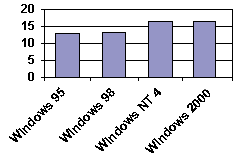
Figure 1. ZD Labs' Business
Winstone comparing averages of five desktop and two notebook systems running three different memory
configurations. (Higher scores represent better performance.)
Networking Performance

Windows 2000 is gigabit ready. This means that Windows 2000 is capable of sustaining the
highest levels of network throughput using gigabit adapters. For
example, using network adapters designed to use the
advanced Transmission Control Protocol/Internet Protocol (TCP/IP) features in Windows 2000,
such as TCP/IP checksum offloading and “large send” support, Windows
2000 can deliver up to 25 percent better network throughput
than Windows NT Server 4.0 (see Figure 2 below) and sustain close to
4 gigabits per second (Gbps) of data throughput. With the
improved networking efficiency provided by Windows 2000, customers will
benefit from higher capacity Web servers, file servers, and
application servers.
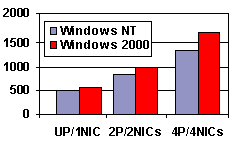
Figure 2. Comparison of network
throughput of Windows NT 4.0 and Windows 2000
on systems measured in megabits per second (Mbps) with different processor (P) and network adapter (NIC) configurations. (Higher scores represent better performance.)
Web Server Performance

The performance of Web sites running Windows NT Server 4.0 can immediately be
improved by upgrading to Windows 2000. Windows 2000 significantly improves in-process Active
Server Pages (ASP) performance and symmetric multiprocessing (SMP)
scalability (see Figure 3 below). In addition, ASP applications
running in out-of-process mode perform significantly better on
Windows 2000. For example, an ASP application running in out-of-process
mode on Windows 2000 is as fast as the same ASP application running in the
Web server process on Windows NT Server 4.0. Furthermore, the raw
performance of serving static Web pages has increased significantly according to
the SPECWeb 96 results available publicly at http://www.spec.org .
.
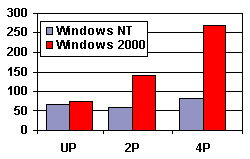
Figure 3. Comparison of in-process
ASP performance of Windows NT 4.0 and Windows 2000 on different processor (P) configurations, measured in requests per second. (Higher scores represent better performance.)
File & Print Server Performance

On account of the many improvements
to its file-server components—such as an increase in size of the
virtual space used for the file cache from 496
megabytes (MB) to 960 MB, an optimized server message
block (SMB) redirector, and an enhanced file
system—Windows 2000 provides customers with a scalable and better
performing file-server solution. Using the NetBench benchmark,
Windows 2000 Server with Windows 2000 Professional-based clients provides
up to 20 percent better performance than Windows NT Server
4.0 with Windows NT Workstation 4.0-based clients (see
Figure 4 below). In some cases, especially where the file
shares are stored on a single partition, Windows 2000
provides up to two times better file-server performance than Windows NT Server 4.0.
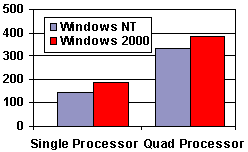
Figure 4.
Comparison of Windows NT 4.0 and Windows 2000 in terms of file server performance on multiple-volume servers, measured in Mbps. (Higher scores represent better performance.)
As a print server, Windows 2000 is capable of processing up to three times more pages per
second when compared to Windows NT Server 4.0 (see Figure 5 below).
Moreover, print performance doesn’t degrade on Windows 2000 Server as
additional printers are added. And Windows 2000 can perform the
rendering in a third of the time it took on Windows NT Server 4.0 and
requires only a third of the CPU resources.
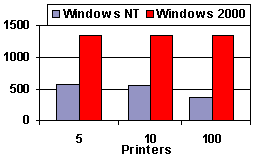
Figure 5. Number of pages a Windows 2000 print server can process per second compared to a Windows NT 4.0 print server.
Application Server Performance

Windows 2000 Server is a better platform for running business applications.
Taken together, better SMP scalability, improved networking performance, and
support for more physical memory make Windows 2000 a superior
application server. The SAP Retail benchmark, designed to test the performance capabilities
of different platforms when running the SAP retailing system, shows
the advantage of using Windows 2000 Advanced Server in
an application server environment (see Figure 6 below).
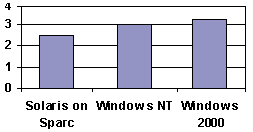
Figure 6. Windows 2000 Advanced Server outperforms both Windows NT Server 4.0, Enterprise Edition, and Sun Solaris in the SAP Retail benchmark tests (measured in millions of lin-items processed per hour).



